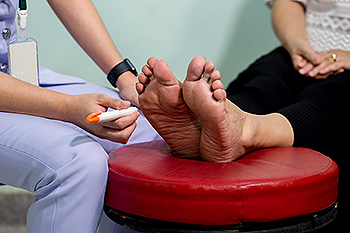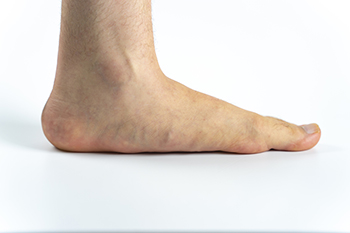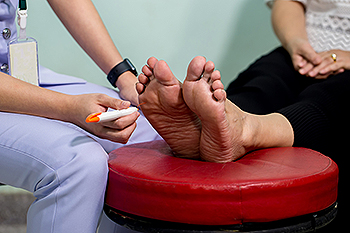April 2022
How Diabetes Can Impact the Feet

When you have diabetes, it is important for you to check your feet each day to make sure you do not have cuts or blisters that are not healing. Since about half of those with diabetes have nerve damage, it can cause one to lose feeling in their feet and they may not be aware there is a problem until it worsens and possibly becomes a more serious issue. It is obvious that the first order of business is managing the diabetes through diet, exercise, and necessary medication, but while this takes place it will be necessary to maintain good foot health practices – washing feet regularly, wearing well-fitting foot coverings, and checking for numbness, tingling, and pain. Those who are older and/or have other physical health problems are said to have a greater risk for complications from diabetic foot problems, such as ulcers or other infections. Since amputation can be the result of untreated foot problems in those with diabetes, it is suggested that regular visits to a podiatrist become part of routine foot health maintenance.
Diabetic foot care is important in preventing foot ailments such as ulcers. If you are suffering from diabetes or have any other concerns about your feet, contact John McGhan, DPM from Gold Canyon Foot & Ankle. Our doctor can provide the care you need to keep you pain-free and on your feet.
Diabetic Foot Care
Diabetes affects millions of people every year. The condition can damage blood vessels in many parts of the body, especially the feet. Because of this, taking care of your feet is essential if you have diabetes, and having a podiatrist help monitor your foot health is highly recommended.
The Importance of Caring for Your Feet
- Routinely inspect your feet for bruises or sores.
- Wear socks that fit your feet comfortably.
- Wear comfortable shoes that provide adequate support.
Patients with diabetes should have their doctor monitor their blood levels, as blood sugar levels play such a huge role in diabetic care. Monitoring these levels on a regular basis is highly advised.
It is always best to inform your healthcare professional of any concerns you may have regarding your feet, especially for diabetic patients. Early treatment and routine foot examinations are keys to maintaining proper health, especially because severe complications can arise if proper treatment is not applied.
If you have any questions please feel free to contact our office located in Gold Canyon, AZ . We offer the newest diagnostic and treatment technologies for all your foot and ankle needs.
What to Do if Your Toe Is Always Bent or Feels Stiff
Middle joints in the second, third, and fourth toes can sometimes become deformed due to an imbalance in tendons, muscles, and ligaments. When this occurs, the toe is unnaturally bent with the middle joint stuck in an upward position while the rest of the toe is bent downward. This deformity causes the toe to look almost like a hammer, which is why it is known as hammertoe. Mallet toe is similar, however, the joint nearest the nail is affected. The factors that can contribute to hammertoe include wearing high heels or other footwear that crowds the toes, throwing the toes out of alignment by stubbing or injuring them, having an imbalance in the toe muscles due to age or other conditions, inheriting a second toe that is longer than the big toe, and suffering from diabetes, arthritis, or other conditions that compromise the feet. It is important to seek treatment from a podiatrist in the early stages of hammertoe, while the toe is still flexible, and the condition is more easily correctable. If your toe is always bent or it looks red or feels stiff or painful at the joint, it is a good idea to make an appointment with a podiatrist to get it examined and to discuss your treatment options.
Hammertoes can be a painful condition to live with. For more information, contact John McGhan, DPM of Gold Canyon Foot & Ankle. Our doctor will answer any of your foot- and ankle-related questions.
Hammertoe
Hammertoe is a foot deformity that occurs due to an imbalance in the muscles, tendons, or ligaments that normally hold the toe straight. It can be caused by the type of shoes you wear, your foot structure, trauma, and certain disease processes.
Symptoms
- Painful and/or difficult toe movement
- Swelling
- Joint stiffness
- Calluses/Corns
- Physical deformity
Risk Factors
- Age – The risk of hammertoe increases with age
- Sex – Women are more likely to have hammertoe compared to men
- Toe Length – You are more likely to develop hammertoe if your second toe is longer than your big toe
- Certain Diseases – Arthritis and diabetes may make you more likely to develop hammertoe
Treatment
If you have hammertoe, you should change into a more comfortable shoe that provides enough room for your toes. Exercises such as picking up marbles may strengthen and stretch your toe muscles. Nevertheless, it is important to seek assistance from a podiatrist in order to determine the severity of your hammertoe and see which treatment option will work best for you.
If you have any questions, please feel free to contact our office located in Gold Canyon, AZ . We offer the newest diagnostic and treatment technologies for all your foot care needs.
When Neuropathy Affects the Feet
Neuropathy can generally be referred to as a disease or dysfunction of the nerves. There are different forms of neuropathy which can occur in various locations of the body. When neuropathy affects the feet, it is a malfunction within the peripheral nervous system—which is a network of nerves outside of the central nervous system (comprising the spinal cord and brain) which controls the feet, hands, legs, and arms. This type of neuropathy is referred to as peripheral neuropathy. Neuropathy can be caused by diabetes, autoimmune diseases, infections, alcoholism, genetic disorders, toxins, medications, tumors, and more. Sometimes there is no known cause for neuropathy. Peripheral neuropathy can cause numbness, tingling, pain, or extreme sensitivity to touch in the feet. It may even cause a loss of feeling in the feet which may lead to an inability to detect rapidly developing sores. If you have any of these symptoms, see a podiatrist as soon as possible to devise an appropriate treatment plan.
Neuropathy
Neuropathy can be a potentially serious condition, especially if it is left undiagnosed. If you have any concerns that you may be experiencing nerve loss in your feet, consult with John McGhan, DPM from Gold Canyon Foot & Ankle. Our doctor will assess your condition and provide you with quality foot and ankle treatment for neuropathy.
What Is Neuropathy?
Neuropathy is a condition that leads to damage to the nerves in the body. Peripheral neuropathy, or neuropathy that affects your peripheral nervous system, usually occurs in the feet. Neuropathy can be triggered by a number of different causes. Such causes include diabetes, infections, cancers, disorders, and toxic substances.
Symptoms of Neuropathy Include:
- Numbness
- Sensation loss
- Prickling and tingling sensations
- Throbbing, freezing, burning pains
- Muscle weakness
Those with diabetes are at serious risk due to being unable to feel an ulcer on their feet. Diabetics usually also suffer from poor blood circulation. This can lead to the wound not healing, infections occurring, and the limb may have to be amputated.
Treatment
To treat neuropathy in the foot, podiatrists will first diagnose the cause of the neuropathy. Figuring out the underlying cause of the neuropathy will allow the podiatrist to prescribe the best treatment, whether it be caused by diabetes, toxic substance exposure, infection, etc. If the nerve has not died, then it’s possible that sensation may be able to return to the foot.
Pain medication may be issued for pain. Electrical nerve stimulation can be used to stimulate nerves. If the neuropathy is caused from pressure on the nerves, then surgery may be necessary.
If you have any questions, please feel free to contact our office located in Gold Canyon, AZ . We offer the newest diagnostic and treatment technologies for all your foot care needs.
Wounds That Don't Heal Need to Be Checked
Two Types of Flat Feet
 There are many people that are born with flat feet. This condition can be identified by standing on the floor and noting if the entire foot lies flat. Additionally, flat feet may be part of a genetic disorder, and there may be pain in the feet and ankles that are associated with it. Research has shown there are two types of flat feet. Rigid flat feet indicate the arch is completely missing, and flexible flat feet show the arch is present when the patient sits or stands. People who have pain that is related to flat feet may find mild relief when custom made orthotics are worn, in addition to wearing sturdy shoes. If there is pain from this condition, it may be associated with tight tendons or bone problems. If you have flat feet, it is suggested that you schedule a visit with a podiatrist who can properly assess this condition.
There are many people that are born with flat feet. This condition can be identified by standing on the floor and noting if the entire foot lies flat. Additionally, flat feet may be part of a genetic disorder, and there may be pain in the feet and ankles that are associated with it. Research has shown there are two types of flat feet. Rigid flat feet indicate the arch is completely missing, and flexible flat feet show the arch is present when the patient sits or stands. People who have pain that is related to flat feet may find mild relief when custom made orthotics are worn, in addition to wearing sturdy shoes. If there is pain from this condition, it may be associated with tight tendons or bone problems. If you have flat feet, it is suggested that you schedule a visit with a podiatrist who can properly assess this condition.
Flatfoot is a condition many people suffer from. If you have flat feet, contact John McGhan, DPM from Gold Canyon Foot & Ankle. Our doctor will treat your foot and ankle needs.
What Are Flat Feet?
Flatfoot is a condition in which the arch of the foot is depressed and the sole of the foot is almost completely in contact with the ground. About 20-30% of the population generally has flat feet because their arches never formed during growth.
Conditions & Problems:
Having flat feet makes it difficult to run or walk because of the stress placed on the ankles.
Alignment – The general alignment of your legs can be disrupted, because the ankles move inward which can cause major discomfort.
Knees – If you have complications with your knees, flat feet can be a contributor to arthritis in that area.
Symptoms
- Pain around the heel or arch area
- Trouble standing on the tip toe
- Swelling around the inside of the ankle
- Flat look to one or both feet
- Having your shoes feel uneven when worn
Treatment
If you are experiencing pain and stress on the foot you may weaken the posterior tibial tendon, which runs around the inside of the ankle.
If you have any questions please feel free to contact our office located in Gold Canyon, AZ . We offer the newest diagnostic and treatment technologies for all your foot and ankle needs.


